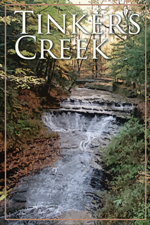
(Cuyahoga River Community Planning)
Tinker's Creek is the Cuyahoga River's largest tributary, gathering water from 13 subwatersheds in 4 counties, and draining nearly 100 square miles before joining the Cuyahoga River at Valley View.
The creek and its watershed contain beautiful waterfalls, dramatic ledges, wetlands, meadows and forests, many of which are located in Tinkers Creek State Park and its adjacent nature preserve.
LOCATION: Northeast Ohio, Cuyahoga, Portage, Summit and Geauga Counties, including the communities of Beachwood, Bedford, Bedford Heights, Glenwillow, Highland Heights, Maple Heights, North Randall, Oakwood Village, Orange Village, Solon, Valley View, Walton Hills, Warrensville Heights, Bainbridge Township, Aurora, Franklin Township, Streetsboro, Sugar Bush Knolls, Hudson Village, Macedonia, Northfield, Reminderville, Twinsburg, and Twinsburg Township
DRAINAGE: approximately 100 square miles
LENGTH: Tinkers Creek is 28.2 miles long. The watershed contains approximately 554 miles of feeder streams and main stem.
GRADIENT: The creek drops an average of 15 feet per mile, although through Tinkers Creek Gorge it drops 220 feet over 2 miles.
LAND COVER: Tinkers Creek is a classic countryside-to-cityside watershed, with open natural areas at its outer headwaters changing to urbanized areas in Cleveland's suburbs. It is interesting to note that in the area where it joins the Cuyahoga, its mouth, the creek returns to relatively natural surroundings.
WATERSHED-SPECIFIC CHALLENGES TO HEALTH AND FUNCTION
• increasing urbanization brings roadways, parking lots, roofs and increases in impervious surfaces, with resulting urban runoff, faster flows and increased volumes of storm water that degrade stream banks and bring litter and petrochemicals into the streams;
• combined sewer overflows (CSOs) allow bacteria-laden sewage to bypass treatment plants and enter waterways untreated during storm events;
• construction at headwaters destroys stream function and changes the soil structure to denser, less permeable soild, encourages erosion, and adds vast amounts of sediment which impairs aquatic life and widens flood areas;
• loss of wetlands, which store and filter water, means more pollution-carrying water pours across the surface and directly into streams. degrading water quality
WATERSHED HYDROLOGY The large number of headwater streams flowing throughout the watershed mean an equally large number of flood plains in the subwatersheds.

Tinker's Creek Watershed Partners is the stewardship group working to protect and restore water quality and habitats of the Tinker's Creek watershed through community partnerships.
The organization sponsors the Ohio Stormwater Conference each year, as well as an annual watershed festival.
Learn more at tinkerscreekwatershed.org
Cuyahoga River Restoration
c/o Cuyahoga River Community Planning
1299 Superior Ave. E • Cleveland, OH 44114
216-241-2414 • info@cuyahogariver.org

